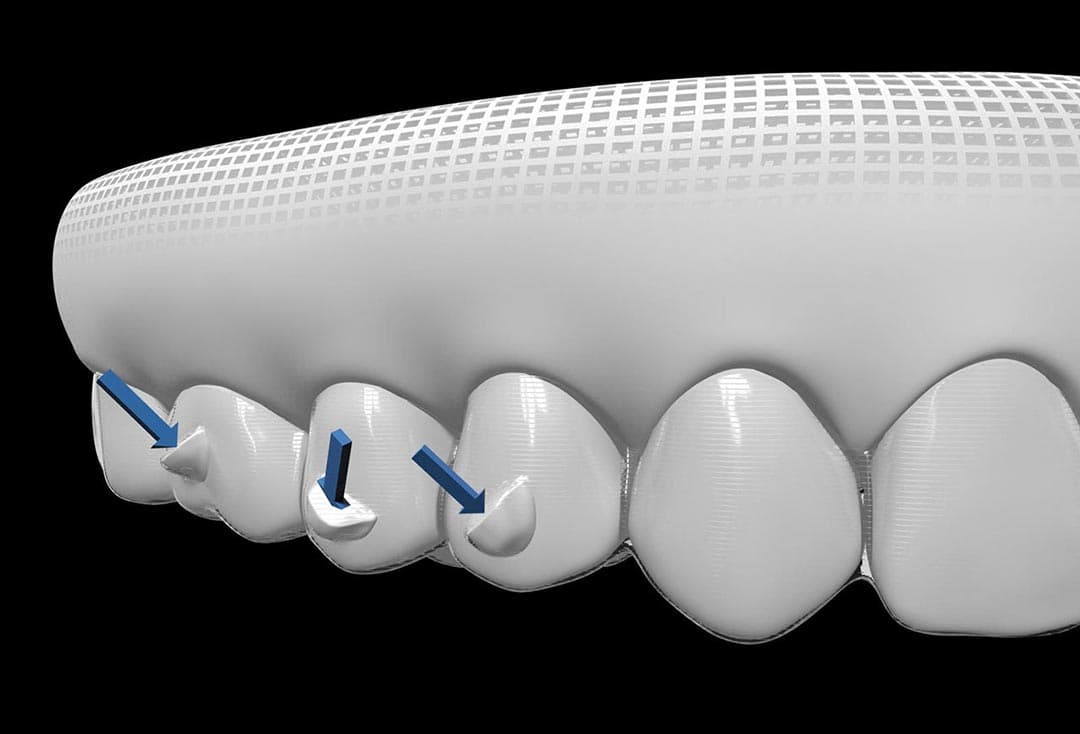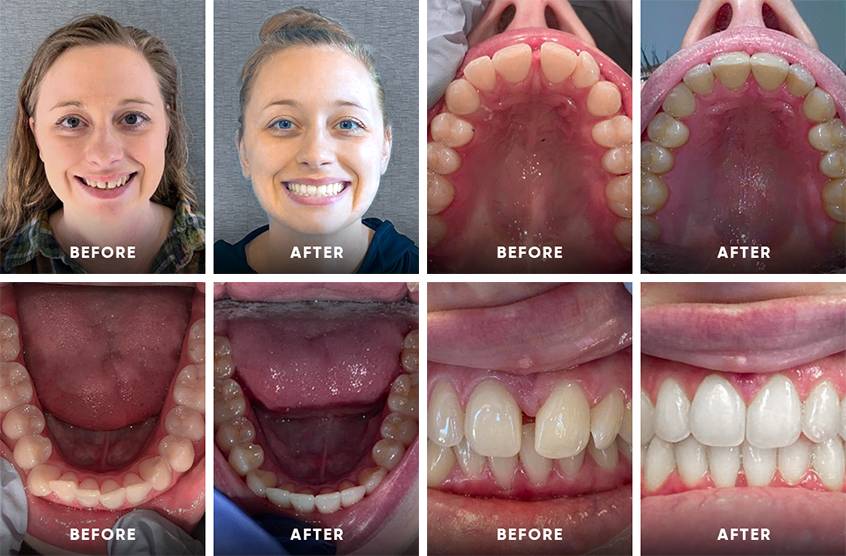Success Stories: How Invisalign Changed Lives and Enhanced Confidence
Wiki Article
Invisalign vs. Typical Braces: Which Option Is Right for You?
When thinking about orthodontic therapy, the selection between Invisalign and traditional braces provides a number of vital factors that merit careful assessment. Invisalign uses a very discreet choice with detachable aligners, while typical dental braces provide a more visible yet effective service for severe misalignment. Each option encompasses distinct benefits and drawbacks associated with aesthetic appeals, convenience, therapy duration, and expense. Comprehending these nuances is crucial for making an informed decision that straightens with your individual choices and way of life. The concern stays: which choice will best meet your orthodontic needs and assumptions?Introduction of Treatment Alternatives

In comparison, traditional braces contain steel braces and cords that are bound to the teeth. This technique applies constant stress with time to achieve alignment. While effective for intricate orthodontic concerns, typical braces need regular gos to for adjustments and can pose obstacles in maintaining oral health because of the difficulty of cleansing about braces and cables.
Both options have their qualities, and the option typically depends upon details dental conditions, lifestyle choices, and individual compliance. Ultimately, speaking with an orthodontic specialist is important for establishing the most ideal treatment strategy tailored to individual requirements. Understanding the nuances of each choice can dramatically influence the total success of orthodontic treatment.
Visual Factors To Consider
A substantial element affecting the choice between Invisalign and typical braces is the aesthetic allure each treatment provides. Invisalign aligners are crafted from clear plastic, making them essentially undetectable when worn. This very discreet look is particularly interesting grownups and young adults who might feel uneasy concerning their orthodontic therapy. The capacity to preserve an all-natural smile throughout the placement procedure can significantly boost the patient's confidence in social and professional settings.On the other hand, standard dental braces contain steel brackets and cords, which can be a lot more visible. While advancements in orthodontic technology have caused the advancement of smaller braces and tinted elastics, standard braces still keep an even more noticeable account. For some individuals, the presence of braces might deter them from seeking necessary therapy.
Eventually, the choice in between Invisalign and standard braces may pivot on individual choices pertaining to looks. People that focus on discernment usually lean toward Invisalign, while those who are much less worried regarding presence might select typical braces. Comprehending the aesthetic ramifications of each option is essential for making an informed choice that lines up with one's lifestyle and choices.
Convenience and Convenience

In regards to comfort, Invisalign aligners are detachable, making it possible for clients to appreciate their preferred foods without limitation and maintain optimum dental hygiene. Brushing and flossing are streamlined, as the aligners can be secured during these regimens, whereas standard braces call for cautious navigating around brackets and cords.
In addition, Invisalign's modern system enables less orthodontic check outs. Patients usually get multiple collections of aligners at the same time, which can improve the therapy process and reduce time invested in the orthodontist's chair. In contrast, typical braces demand routine changes, making them less hassle-free for those with hectic timetables. Invisalign. Generally, the comfort and benefit of Invisalign make it an attractive selection for lots of people seeking orthodontic therapy.
Therapy Period and Performance
While both Invisalign and typical braces are efficient in dealing with oral misalignments, the duration of treatment can differ considerably between the 2 alternatives. Usually, Invisalign treatment can take websites anywhere from 12 to 18 months, depending upon the intricacy of the instance. The clear aligners function by gradually shifting teeth into their preferred placements, and normal follow-ups with an orthodontist help ensure development stays on the right track.
In comparison, traditional braces frequently need a longer commitment, normally varying from 18 months to 3 years. This is because of their set nature and making use of cables and braces, which can be a lot more efficient for complicated situations and serious misalignments (Invisalign). The treatment effectiveness of traditional braces is well-documented, as they enable specific changes and better control over tooth activity
Eventually, the option between Invisalign and traditional braces might pivot on both the expected treatment duration and the specific oral problems available. Consulting with an orthodontist is important, as they can offer tailored referrals based upon private needs, ensuring the picked approach lines up with desired end results and durations.
Expense Comparison and Insurance Options
Price plays a considerable role in the decision-making procedure for individuals considering orthodontic therapy, whether going with Invisalign or traditional dental braces. Generally, the price of Invisalign varieties from $3,000 to $8,000, while traditional dental braces usually cost in between $2,000 and $6,000. Factors affecting these costs include the intricacy of the case, the period of treatment, and geographical area.Insurance insurance coverage can substantially impact out-of-pocket expenditures. Numerous oral insurance strategies offer partial insurance coverage for orthodontic treatments, however the specifics can differ commonly. It is crucial for individuals to review their insurance plan to identify the level of coverage for either choice. Usually, conventional dental braces might be much more regularly covered by insurance plans contrasted to Invisalign, which some insurance providers classify as an aesthetic procedure.
Additionally, several orthodontic methods use versatile layaway plan, making both treatment options much more easily accessible. Individuals need to make inquiries concerning potential financing options and discounts for upfront payments. Evaluating the total cost, including insurance benefits and layaway plan, is essential for making an informed choice that straightens with both visual choices and budget plan considerations.

Verdict
In recap, the selection in between Invisalign and standard braces depends upon multiple factors, including visual choices, comfort, treatment duration, and price. Invisalign supplies a very discreet, removable option that facilitates dental health and dietary flexibility, while traditional dental braces might be much more suitable for complex oral problems and typically come at a reduced cost point. Inevitably, appointment with an orthodontist is vital to evaluate individual More Help conditions and figure out the most appropriate therapy option for attaining ideal dental placement.When taking into consideration orthodontic therapy, the choice in between Invisalign and standard braces provides several vital elements that warrant cautious evaluation.Contrasting Invisalign and traditional dental braces reveals distinctive treatment choices for orthodontic correction.While both Invisalign and typical braces are reliable in correcting oral misalignments, the duration of therapy can vary dramatically between the 2 alternatives.Expense plays a best site substantial role in the decision-making procedure for people thinking about orthodontic therapy, whether opting for Invisalign or conventional dental braces.In summary, the option in between Invisalign and traditional braces pivots on numerous elements, consisting of visual preferences, comfort, therapy period, and cost.
Report this wiki page